Blogs
Travelling during a Global Pandemic
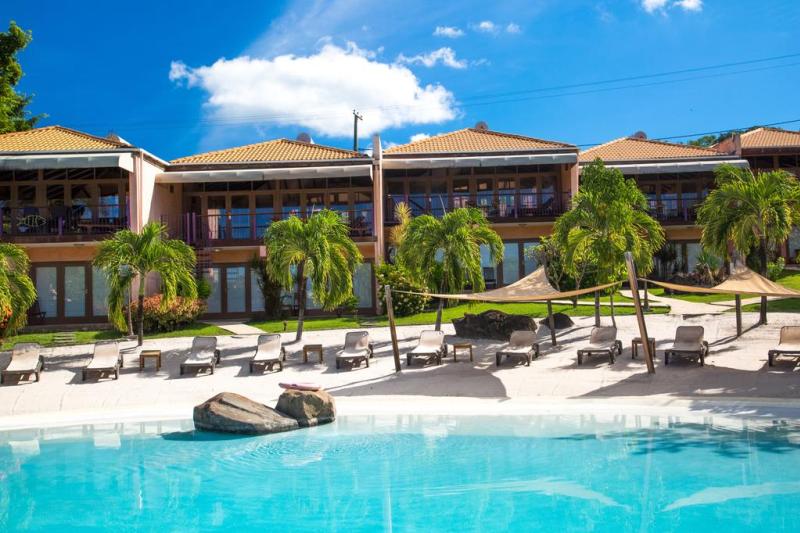
Blog by John Spencer-Ades at The Scuba Place
The year 2020 has been, let’s say, interesting, at the least!
The World has been held to ransom by an invisible bug, and the impact has been both deep on a personal level and wide on a global society level. Families have been separated, friends and social life put on hold, people have lost loved ones and businesses have been decimated.
I have learned that I took life for granted to a certain extent – hopping on a plane to go on a dive trip was a very regular activity. Then came COVID-19, and with it, a dawning sense of reality that travel (and indeed diving to a lesser extent) was no longer a right.
With zero income from booking trips for people, plentiful outgoings in the form of giving refunds, and an immediate focus on re-booking existing trips for later in the year, my initial optimism that this would be a short-term thing fell flat on its face when lockdown (v1.0) was implemented.
As the Summer of Discontent extended into the Autumn of Austerity, we focused all of our efforts on constantly monitoring where we were might be able to travel to. The good old FCO list was indeed pretty useless on this note, as it lists only countries that we are allowed to travel back to the UK from, and not necessarily to. The vast majority of the rest of the World doesn’t want us anywhere near them it seems. And, to boot, there are numerous countries that didn’t accurately publish their entry protocols.
We booked group trips in September to various destinations, and then cancelled them or postponed 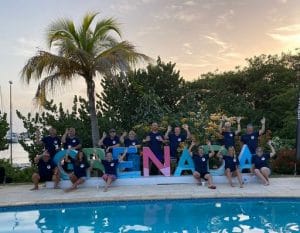 them – again. We found new destinations that we could travel to with good diving, booked them, and then the ‘green list’ changed again. We had clients arrive at Gatwick for their outbound flight, only to be told that the rules had changed again, and they would need to quarantine upon return. And we also had clients in resort have their return to the UK impacted, both by the changes made in entry protocols, and indeed the airlines.
them – again. We found new destinations that we could travel to with good diving, booked them, and then the ‘green list’ changed again. We had clients arrive at Gatwick for their outbound flight, only to be told that the rules had changed again, and they would need to quarantine upon return. And we also had clients in resort have their return to the UK impacted, both by the changes made in entry protocols, and indeed the airlines.
So, arranging travel has been like herding cats this year – every itinerary moved, and multiple times but here is the important bit… we actually got to travel in October.
The FCO list stated travel to Grenada was finally permissible, the Grenada Health Authority had clearly set out their COVID protocols for entry and stay, so we had little or no hesitation in booking a trip – for 18 of us! This was a trip that had been rearranged twice already, but the light was green at last!
And here began the challenge……….
Firstly, and easily, we booked our flights with British Airways – direct to Grenada but in reality, with a scheduled touch down in St Lucia. Then came the pre-departure PCR Testing – we had to have one done (and with negative results of course!) 7 days before departure.
Good old BA have a partnership with one of the testing labs, so we all booked and paid for this on-line, taking advantage of the BA discount. The test kits are sent to you by post, you register them online and take the test.
Planning when to take the test is a task – we flew on a Wednesday, so needed to take the test the previous Thursday at the earliest (for entry validity) and by Friday at the latest to ensure we got the results back in time for our departure. So, we stuck cotton buds down each other’s throats, extracted all sorts of bodily fluids, inserted the swab into the test tube, popped them in the post, and waited! The preferential postage service included did the trick, and results were back for some as early as Saturday!
Then less than 20 hours before departure, we received the dreaded email – the flight to Grenada was cancelled! BA offered to take us to either Barbados or St Lucia. Not especially helpful, as both those destinations have different COVID entry requirements and rules for visitors, so for the third time, this trip looked like it was doomed. Those who hadn’t checked in got a phone call from yours truly to explain the situation – some of them were on their way to Gatwick from all parts of the country to stay in a hotel the night before!
There were no available flights on domestic airlines between St Lucia and Grenada and we couldn’t go to Barbados as PCR tests were required within 96 hours of departure and we now didn’t have time to get another test done. Even staying in St Lucia wasn’t an option, as the entry rules required prior registration and approval. There was no other route, as all roads to Grenada are via St Lucia, Barbados or the USA, which is an even bigger ‘no-no’ than the first two choices when it comes to entry, quarantine and all that malarkey.
So, we did what any super-sensible person would have done. Cancel? No – we chartered a private plane 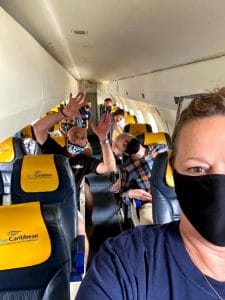 from St Lucia to Grenada, departing some 1 hour after having landed in St Lucia.
from St Lucia to Grenada, departing some 1 hour after having landed in St Lucia.
Wednesday morning at Gatwick was surreal. Empty. Desolate. Like a ghost-town. Well, apart from the check in lines as there were so many people who hadn’t been made aware of the flight cancellation.
Security – I have never been through security so fast, even when flying up in the front of the plane. Boarding was super-efficient and socially distanced, and the plane itself was so clean it could have been brand new.
Reassured by the HEPA filters making the aircraft purportedly as clean as an operating theatre, and with face masks donned, we sat and awaited departure. Sure enough, the doors closed, we backed away from the gate and hit the skies. Passengers on the flight (it was approximately 60% full) were all extremely well behaved, wore their masks, didn’t queue for the loos, and generally sat still and helped to empty the bar. This is how a flight should be!
Arriving in St Lucia was even more streamlined – whipped off the plane, personally escorted through test checks, temperature checks, immigration and baggage – and then immediately onto our onward flight. It really could not have been simpler or easier, even with the distraction of spotting a very well-known actor in the queue!
Arriving in Grenada, some 35 minutes after departing St Lucia, was a breeze too. We got a full health briefing, temperature checks and signed our health disclaimers – then it was straight to baggage, immigration, transport, and finally, FINALLY, our resort – True Blue Bay Boutique Resort!
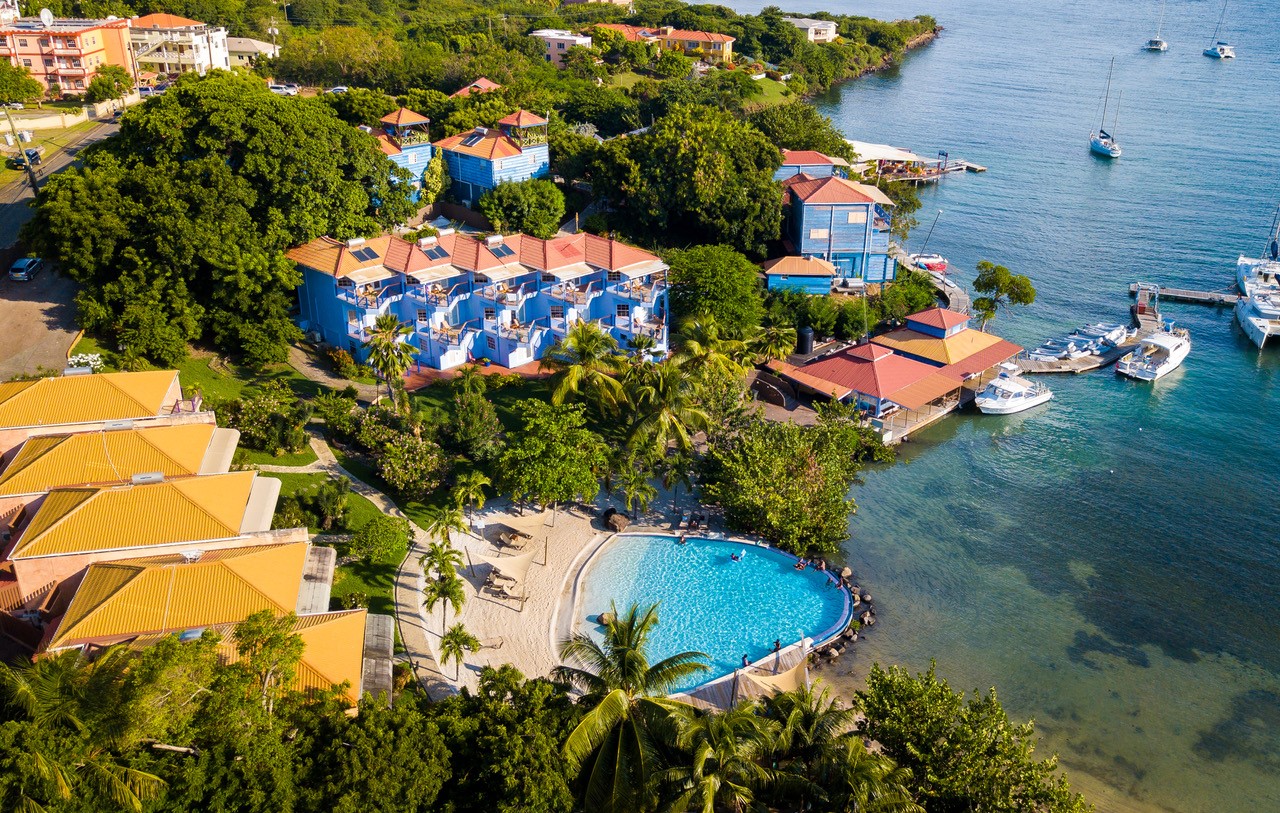
True Blue Bay Resort, Grenada
Given the COVID regulations in Grenada, we were to be held in ‘quarantine’ in the Hotel for the first 4 days, then a test provided by the Ministry of Health on day 5 before being let loose on the island thereafter. Our expectation of quarantine was way more stringent than the reality!
We were shepherded to our rooms, all of which were in one central area, unpacked, and then hit the ‘Quarantine Pool’ – our very own private pool with bar! What could be better than this?! Meals were served in a separate dining room by the water’s edge, and if we didn’t want what was offered on the buffet, we ordered a la carte from the menu. In all honesty, it was like having our own private resort!
Diving was permitted too, as Aquanauts Grenada sit right on the dock in the quarantine area, so after a good night’s sleep, albeit with a very early rise, we humped our kit onto the dive boat, set up, went through the dive and H+S briefings and off we set!
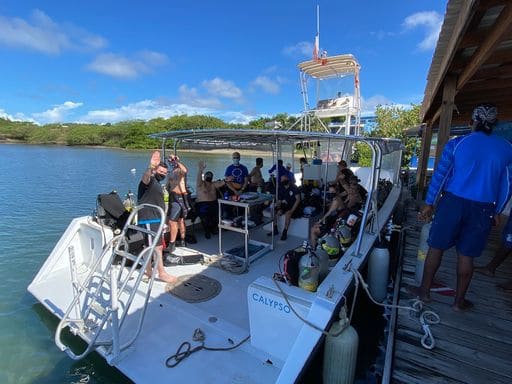
Day 5 had us all lined up like school children outside of the Medical Centre at the resort. Ministry of Health doctors and nurses put nasty things way too far up our noses and into our throats, and the testing was complete – 24 hours later we were all set free!
Breaking out of the quarantine area was great, and we got to take in the whole resort, have a day trip exploring the island, and use the a la carte restaurant and other pools. As brilliant as it was to be ‘free’ we missed our own pool!
So, what was travelling in the COVID World really like?
The airports at all stages of the journeys were exceptionally well organised. Social distancing was almost everywhere, and well adhered to. Masks were worn on all flights and at the airports, in transport to and from the resort, and in the resort itself, floor markings were everywhere, together with numerous hand sanitiser stations. Grenada itself, the resort and the dive centre, really got this right, and we had absolutely no fears.
We wore masks in the public areas of the resort, when interacting with staff (at the bar for example) and on the dive boats. We were even given souvenir masks by the Tourist Board!
Was it a hassle? Absolutely not. In truth, the actual travel was very little different to a ‘normal’ trip (I can remember those, but only just!). We experienced better space – more room on the planes, less crowding at the airports and in resort, and as we travelled as a group, we had our own dive boat. Honestly, it couldn’t have been any better!
What we did learn throughout the whole process of planning and execution of travel during this pandemic, is that we had to be, even more so than usual, ready to deal with last minute changes. So, even with a few hiccups on the way out and back that took some fixing, we had a GREAT time, and made it home safe and sound. And, COVID-free too, but just in time for lockdown v2.0.
If we hadn’t travelled with ATOL protection, and didn’t have comprehensive travel insurance, this could have been a very costly and exhausting experience.
Would we travel again during this pandemic? Yes, and without concern. But only with ATOL and/or ABTA Protection.
Our advice to all who are considering travel during these times is as follows:
- Be prepared for changes – flights, transport, COVID rules. If you have a top-notch bonded Travel Agent behind you, you should have little to worry about.
- Masks – the cloth ones are super comfortable, and you forget you are wearing them.
- Hand sanitiser – take it with you and use it!
- And finally, remember you are on holiday – relax, even if it hurts!
As we look to the future, we are hopeful. Vaccines are coming, testing on departure and return is available, and the rules are changing daily, making it less restrictive in terms of where we can go, and return from with shorter or zero quarantine. We expect there to be highs and lows in our ability to travel over the coming months, and we will just have to deal with them as they arise. COVID is by no means over, but we can see a light at the end of the tunnel.
Our sincerest of thanks for all of the expert support and organisation go out to Grenada Ministry of Health, Grenada Tourist Board, True Blue Bay and Aquanauts Grenada. You got it so, so right!
We will be back!
Find out more about the worldwide dive itineraries that The Scuba Place offers at 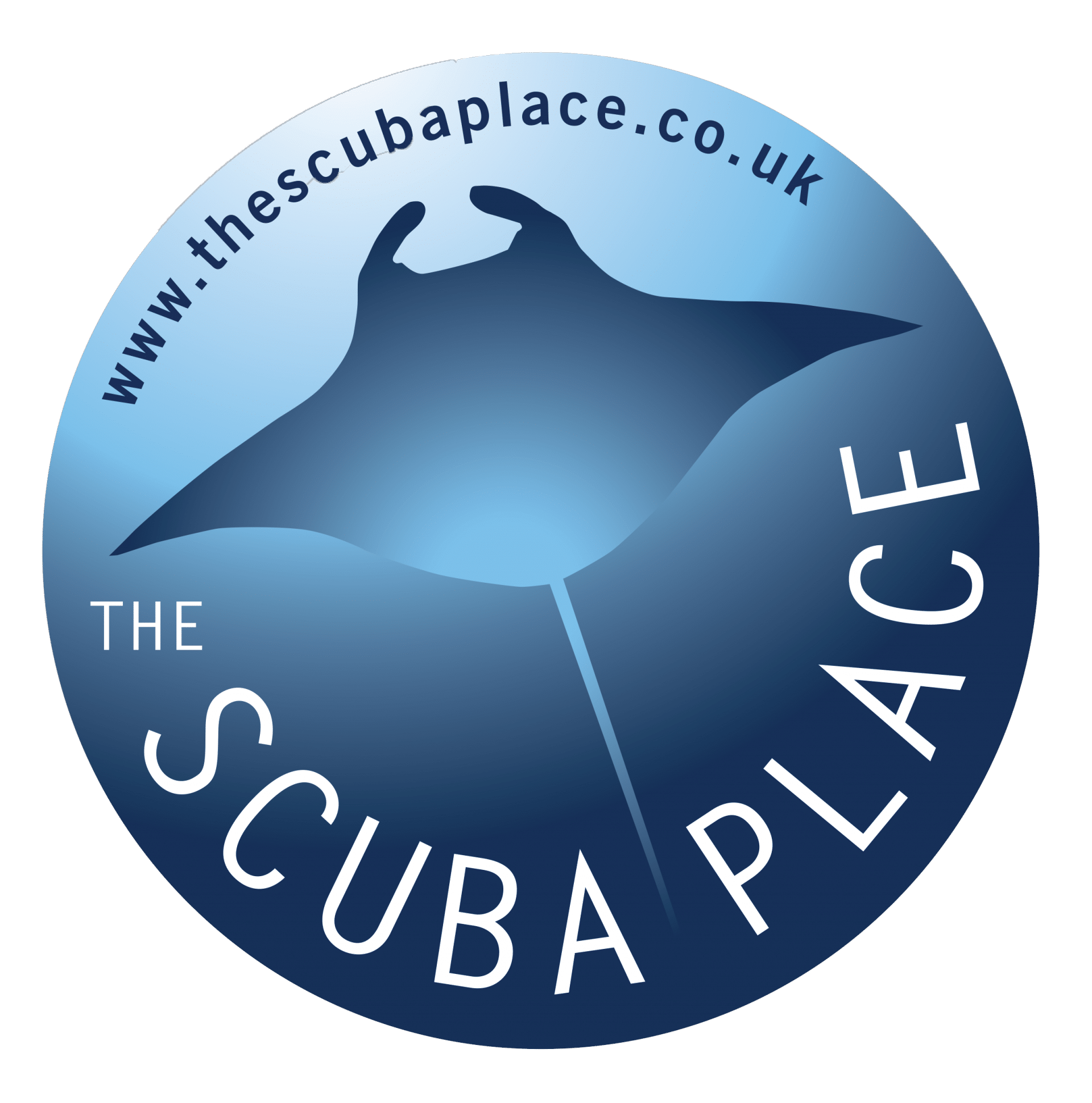 www.thescubaplace.co.uk.
www.thescubaplace.co.uk.
Blogs
Northern Red Sea Reefs and Wrecks Trip Report, Part 3: The Mighty Thistlegorm

Jake Davies boards Ghazala Explorer for an unforgettable Red Sea diving experience…
Overnight, the wind picked up, making the planned morning dive a bit bumpy on the Zodiacs to the drop point on Thomas Reef. There, we would dive along the reef before descending through the canyon and then passing under the arch before ascending the wall with a gentle drift. The site provided great encounters with more pelagic species, including shoals of large barracuda, tuna, and bigeye trevally.
Once back on the boat, it was time to get everything tied down again as we would head back south. This time, with the wind behind us, heading to Ras Mohammed to dive Jackfish Alley for another great gentle drift wall dive before then heading up the coast towards the Gulf of Suez to moor up at the wreck of the Thistlegorm. This being the highlight wreck dive of the trip and for many onboard, including myself, it was the first time diving this iconic wreck. I had heard so much about the wreck from friends, and globally, this is a must on any diver’s list. Fortunately for us, there was only one other boat at the site, which was a rarity. A great briefing was delivered by Ahmed, who provided a detailed background about the wreck’s history along with all the required safety information as the currents and visibility at the site can be variable.

Kitting up, there was a lot of excitement on deck before entering the water and heading down the shoreline. Descending to the wreck, there was a light northerly current which reduced the visibility, making it feel more like the conditions that can be found off the Welsh coast. At 10m from the bottom, the outline of the wreck appeared as we reached the area of the wreck which had been bombed, as our mooring line was attached to part of the propeller shaft. Arriving on deck, instantly everywhere you looked there were many of the supplies which the ship was carrying, including Bren Carrier tanks and projectiles that instantly stood out.

We headed around the exterior, taking a look at the large propeller and guns mounted on deck before entering the wreck on the port side to take a look in the holds. It was incredible to see all the trucks, Norton 16H, and BSA motorcycles still perfectly stacked within, providing a real snapshot in time.

Overall, we had four dives on the Thistlegorm, where for all of the dives we were the only group in the water, and at times, there were just three of us on the whole wreck, which made it even more special, especially knowing that most days the wreck has hundreds of divers. Along with the history of the wreck, there was plenty of marine life on the wreck and around, from big green turtles to batfish, along with shoals of mackerel being hunted by trevally. Some unforgettable dives.

The final leg of the trip saw us cross back over the Suez Canal to the Gobal Islands where we planned to stay the night and do three dives at the Dolphin House for the potential of sharing the dive with dolphins. The site, which included a channel that was teeming with reef fish, especially large numbers of goatfish that swam in large shoals along the edge of the reef. These were nice relaxing dives to end the week. Unfortunately, the dolphins didn’t show up, which was okay as like all marine life they are difficult to predict and you can’t guarantee what’s going to be seen. With the last dive complete, we headed back to port for the final night where it was time to clean all the kit and pack before the departure flight the next day.

The whole week from start to finish on Ghazala Explorer was amazing; the boat had all the facilities you need for a comfortable week aboard. The crew were always there to help throughout the day and the chefs providing top quality food which was required after every dive. The itinerary providing some of the best diving with a nice mixture of wreck and reef dives. I would recommend the trip to anyone, whether it’s your first Red Sea liveaboard in the Red Sea or you’re revisiting. Hopefully, it’s not too long before I head back to explore more of the Red Sea onboard Ghazala Explorer.

To find out more about the Northern Red Sea reef and wrecks itineraries aboard Ghazala Explorer, or to book, contact Scuba Travel now:
Email: dive@scubatravel.com
Tel: +44 (0)1483 411590
Photos: Jake Davies / Avalon.Red
Blogs
Northern Red Sea Reefs and Wrecks Trip Report, Part 2: Wall to Wall Wrecks

Jake Davies boards Ghazala Explorer for an unforgettable Red Sea diving experience…
The second day’s diving was a day full of wreck diving at Abu Nuhas, which included the Chrisoula K, Carnatic, and Ghiannis D. The first dive of the day was onto the Chrisoula K, also known as the wreck of tiles. The 98m vessel remains largely intact where she was loaded with tiles which can be seen throughout the hold. The stern sits at 26m and the bow just below the surface. One of the highlights of the wreck is heading inside and seeing the workroom where the machinery used for cutting the tiles are perfectly intact. The bow provided some relaxing scenery as the bright sunlight highlighted the colours of the soft coral reef and the many reef fish.

Following breakfast, we then headed to the next wreck, which was the Carnatic. The Carnatic is an 89.9m sail steamer vessel that was built in Britain back in 1862. She ran aground on the reef back in 1869 and remains at 27m. At the time, she was carrying a range of items, including 40,000 sterling in gold. An impressive wreck where much of the superstructure remains, and the two large masts lay on the seafloor. The wooden ribs of the hull provide structures for lots of soft corals, and into the stern section, the light beams through, bouncing off the large shoals of glass fish that can be found using the structure as shelter from the larger predators that are found outside of the wreck.

The final wreck at Abu Nuhas was the Ghiannis D, originally called ‘Shoyo Maru,’ which was 99.5m long and built in Japan back in 1969 before becoming a Greek-registered cargo ship in 1980. The ship then ran aground on the reef on April 19th, 1983, and now sits at the bottom at a depth of 27m. Heading down the line, the stern of the ship remains in good condition compared to the rest of the hull. The highlight of the wreck, though, is heading into the stern section and down the flights of stairs to enter the engine room, which remains in good condition and is definitely worth exploring. After exploring the interior section of the ship, we then headed over to see the rest of the superstructure, where it’s particularly interesting to see the large table corals that have grown at the bow relatively quickly considering the date the ship sank. After surfacing and enjoying some afternoon snacks, we made sure everything was strapped down and secured as we would be heading north and crossing the Gulf of Suez, where the winds were still creating plenty of chop.

The next morning, it was a short hop to Ras Mohammed Nature Reserve for the next couple of days of diving. The 6am wake-up call came along with the briefing for the first site we would be diving, which was Shark & Yolanda. The low current conditions allowed us to start the dive at Anemone City, where we would drift along the steep, coral-filled wall. These dives involved drifts, as mooring in Ras Mohammed wasn’t allowed to protect the reefs. As a dive site, Shark & Yolanda is well-known and historically had a lot of sharks, but unfortunately not so many in recent years, especially not so early in the season. However, there was always a chance when looking out into the blue.

The gentle drift took us along the steep walls of the site, with plenty of anemone fish to be seen and a huge variety of corals. It wasn’t long into the dive before we were accompanied by a hawksbill turtle, who drifted with us between the two atolls before parting ways. Between the two reefs, the shallow patch with parts of coral heads surrounded by sand provided the chance to see a few blue-spotted stingrays that were mainly resting underneath the corals and are always a pleasure to see. With this being the morning dive, the early sunlight lit up the walls, providing tranquil moments. Looking out into the blue, there was very little to be seen, but a small shoal of batfish shimmering underneath the sunlight was a moment to capture as we watched them swim by as they watched us.

Towards the end of the dive, we stopped at the wreck of the Jolanda where the seafloor was scattered with toilets from the containers it was carrying. This provided a unique site to make a safety stop, which was also accompanied by a large barracuda slowly swimming by, along with a hawksbill turtle calmly swimming over the reef as the sun rays danced in the distance.
For the next dive, we headed north to the Strait of Tiran to explore the reefs situated between Tiran Island and Sharm El Sheik, which were named after the British divers who had found them. We started on Jackson before heading to Gordons Reef, where we also did the night dive. All the atolls at these sites provided stunning, bustling coral reefs close to the surface and steep walls to swim along, which always provided the opportunity to keep an eye out for some of the larger species that can be seen in the blue. Midwater around Jackson Reef was filled with red-toothed triggerfish and shoals of banner fish, which at times were so dense that you couldn’t see into the blue. Moments went by peacefully as we enjoyed the slow drift above the reef, watching these shoals swim around under the mid-afternoon sun.

The night dive at Gordon’s Reef was mainly among the stacks of corals surrounded by sand, which was great to explore under the darkness. After some time circling the corals, we came across what we were really hoping to find, and that was an octopus hunting on the reef. We spent the majority of the dive just watching it crawl among the reef, blending into its changing surroundings through changes in colour and skin texture. It’s always so fascinating and captivating to watch these incredibly intelligent animals, in awe of their ability to carry out these physical changes to perfectly blend into the reef. Before we knew it, it was time to head back to the boat to enjoy a well-deserved tasty dinner prepared by the talented chefs onboard.
Check in for the 3rd and final part of this series from Jake tomorrow!
To find out more about the Northern Red Sea reef and wrecks itineraries aboard Ghazala Explorer, or to book, contact Scuba Travel now:
Email: dive@scubatravel.com
Tel: +44 (0)1483 411590
Photos: Jake Davies / Avalon.Red
-

 News3 months ago
News3 months agoHone your underwater photography skills with Alphamarine Photography at Red Sea Diving Safari in March
-

 News3 months ago
News3 months agoCapturing Critters in Lembeh Underwater Photography Workshop 2024: Event Roundup
-

 Marine Life & Conservation Blogs3 months ago
Marine Life & Conservation Blogs3 months agoCreature Feature: Swell Sharks
-

 Blogs2 months ago
Blogs2 months agoMurex Resorts: Passport to Paradise!
-

 Blogs2 months ago
Blogs2 months agoDiver Discovering Whale Skeletons Beneath Ice Judged World’s Best Underwater Photograph
-

 Gear Reviews2 weeks ago
Gear Reviews2 weeks agoGEAR REVIEW – Revolutionising Diving Comfort: The Sharkskin T2 Chillproof Suit
-

 Marine Life & Conservation2 months ago
Marine Life & Conservation2 months agoSave the Manatee Club launches brand new webcams at Silver Springs State Park, Florida
-

 Gear Reviews3 months ago
Gear Reviews3 months agoGear Review: Oceanic+ Dive Housing for iPhone
















